The Daily Alaska empire Newspaper, July 19, 1943, Page 6
You have reached the hourly page view limit. Unlock higher limit to our entire archive!
Subscribers enjoy higher page view limit, downloads, and exclusive features.
PAGE SIX _ ___THE DAILY ALASKA EMPIRE—_JUNEAU ALASKA MONDAY, Through the dark of night, and the heat of day, America’s piane spotters have kept their lonely watch. Theirs is a job without recompense, with- out glory, without even the thrill of danger— yet they have kept to ¢/ posts. But there are times, when the fog rolls in or the skies are dark, that even the keenest human eyes are not enough. Then, along our shores and about our cities, we can depend on electronic sentries to scan the skies. / e dericas ée,ff//d/ze spolter,’ / /5 BLINDJJ‘JBA /f, ’ n RADAR is America’s best plane spotter. Like the bat, which is equipped by nature with one of the most remarkable sets of blind-flying “instruments” known to man, radar can operate “blind” in night and fog. Waves from electronic tubes, incessantly scanning the skies, can “feel” through the dark the approach of an enemy plane. Radar, and the Spitfires, stopped the Stukas in the skies over England in 1940. Radar, helping to direct the fire of an American warship in the Pacific, enabled it to hit a What is Electronics, Anyway? 1. What is an electron? The electron is one of the fundamental particles of matter and electricity. Electrons are part of atoms; atoms make up molecules. And molecules, in turn, make up all the matter in the world, and in the uni- verse of which the world is but a small part. The elec~ tron is far too small to be seen, even with the best microscopes. Thirty thousand trillion trillion electrons would weigh less than one ounce! Electronics is the science of electrons. 2. Who discovered electronics? No one person. Electronics has grown as the result of the work of many scientists, in many countries, over the past 60 years. It is growing faster today than ever ; ‘ P Sy ‘ 3 by before, as scientists learn more about electrons and Japanese Wal’Shlp 8 miles away 1n pltCh darkness. EIeCtran'cs isa Peavehme Sc‘e”ce: _WC know it § > i et how to use them. Yet radar is no more mi- best through radio, a great and essential industry. But 47 raculous than your radio set. electronics works in almost every other industry, too— measuring in millionths of an inch, converting electric current to heat steel furnaces and to refine aluminum and magnesium, seeing through inches of steel, protecting property and human lives, regulating lighting. And elec- tronic controls enable women to do many complex jobs in industry, releasing men for war, Army and Navy, many in college and industrial research But the destiny of elec- laboratories—played a part in its development. And Gen- tronics is not to replace—it is What is the difference between an electronic tube and a radio tube? It is simply the application of principles discovered many years ago. Many sci- entists and engineers—in this country and in Britain, some working alone, some in the A radio tubeisone of the many kinds of electron tubes. aried as the jobs they do. Some are small They are as as a thimble, others big as a man. Some are vacuum tubes, others contain rare gases. Some are made of glass, others of steel. New types are being developed all the time. . Is television an electronic development? Yes. So is the radio, the X-ray, radar. Electronic tubes FEA ey . 4 work in the long-distance telephone; they control im- Cl’n’ll‘E‘lCCtl‘lCWd\s(meofthefirs[and mostactivein this field. to add to the products and 7 portant processes in industry; they count and sort This was only natural. For, when in 1940 the Navy re- services we enjoy, and to and safeguard. New uses are being found almost every quested G.E. to begin the manufacture of radar equip- make easier our ways of ob- T day. 3 kd Y ment, we had been for more than 20 years engaged in the taining them. Things like 4 development and manufacture of the kind of electron television merely await the tubes, circuits, and apparatus that makes radio, and 7adar, ~ war’s end. And in the elec- possible. Additional manufacturing facilities were started tronic laboratories of today are the seeds of other, of new . at once. And today, General Electric is supplying this and undreamed-of benefits for tomorrow. General Elec- equipment in quantity for the Army and the Navy. tric Company, Schenectady, N. Y. 5. What does electronics promise for the future? Many things. New products and services, new medical tools to hely d human health. Perhaps equally important, it will give us a tool by which we can make things faster, better, and cheaper, so that we can all afford more of, them. SOME PEACETIME USES OF ELECTRONIC TUBES Textile, steel, and paper mill control Home Radio Elevator leveling FREE -, 4-page “Primer of Electron- scs,” explaining the simple principles of electronic tubes. For your copy write Dept. 6-201, General Electric Company, * The best investment in the world 1 s in this country’s future— uunn e BUY WAR BONDS You are invited to listen to “The World Today" at 6:45 p. m., EWT, Monday through Saturday, on CBS, and the “Hour of Charm" 10 p. m., EWT, Sundays, on NBC.

